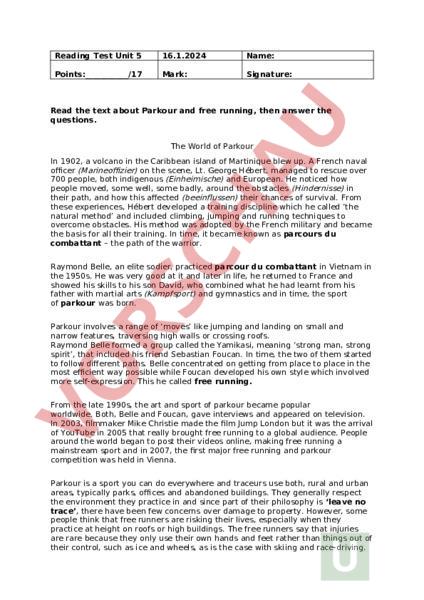Arbeitsblatt: Reading Unit 5 New Inspiration 3
Material-Details
Leseverständnis passend zur Unit 5 vom New Inspiration 3
Englisch
Lesen / Literatur
9. Schuljahr
2 Seiten
Statistik
208994
448
7
29.03.2024
Autor/in
Calimero (Spitzname)
Land: Schweiz
Registriert vor 2006
Textauszüge aus dem Inhalt:
Reading Test Unit 5 16.1.2024 Name: Points:_/17 Mark: Signature: Read the text about Parkour and free running, then answer the questions. The World of Parkour In 1902, volcano in the Caribbean island of Martinique blew up. French naval officer (Marineoffizier) on the scene, Lt. George Hébert, managed to rescue over 700 people, both indigenous (Einheimische) and European. He noticed how people moved, some well, some badly, around the obstacles (Hindernisse) in their path, and how this affected (beeinflussen) their chances of survival. From these experiences, Hébert developed training discipline which he called ‘the natural method and included climbing, jumping and running techniques to overcome obstacles. His method was adopted by the French military and became the basis for all their training. In time, it became known as parcours du combattant – the path of the warrior. Raymond Belle, an elite sodier, practiced parcour du combattant in Vietnam in the 1950s. He was very good at it and later in life, he returned to France and showed his skills to his son David, who combined what he had learnt from his father with martial arts (Kampfsport) and gymnastics and in time, the sport of parkour was born. Parkour involves range of ‘moves like jumping and landing on small and narrow features, traversing high walls or crossing roofs. Raymond Belle formed group called the Yamikasi, meaning ‘strong man, strong spirit, that included his friend Sebastian Foucan. In time, the two of them started to follow different paths. Belle concentrated on getting from place to place in the most efficient way possible while Foucan developed his own style which involved more self-expression. This he called free running. From the late 1990s, the art and sport of parkour became popular worldwide. Both, Belle and Foucan, gave interviews and appeared on television. In 2003, filmmaker Mike Christie made the film Jump London but it was the arrival of YouTube in 2005 that really brought free running to global audience. People around the world began to post their videos online, making free running mainstream sport and in 2007, the first major free running and parkour competition was held in Vienna. Parkour is sport you can do everywhere and traceurs use both, rural and urban areas, typically parks, offices and abandoned buildings. They generally respect the environment they practice in and since part of their philosophy is ‘leave no trace, there have been few concerns over damage to property. However, some people think that free runners are risking their lives, especially when they practice at height on roofs or high buildings. The free runners say that injuries are rare because they only use their own hands and feet rather than things out of their control, such as ice and wheels, as is the case with skiing and race-driving. 1 George Hebert developed parcour du combattant because. he saw native people doing it in Martinique. he saw how it could save lives. he saw how the French were not good at overcoming obstacles. 2 The natural method. saved the peoples life in Martinique. was taught to Hebert by indigenous people. was practiced by the French military. 3 True or false? Raymond Belle invented the parcours du combattant Raymond Belle taught David how to do parcours. David combined parcours with martial art and gymnastics. Parkour is one special move to get from one point to another. When you practice parkour jumping is not allowed. Yamikasi is group of people who practice parkour. Free running is like parkour but more creative. 4 What impact did youtube have on free running? Explain with your own words. 5 traceur is. parkour move. someone who practices parkour. an obstacle in parkour course. 6 Explain their philosophy leave no trace with your own words. 7 Which of the following is NOT true about free running? there are lot of accidents when they practise. there are now international competitions. people who practise free running often cause damage to the environment. 8 Parkour and free running practitioners. have lot of equipment. use their own bodies. dont take risks. /17
